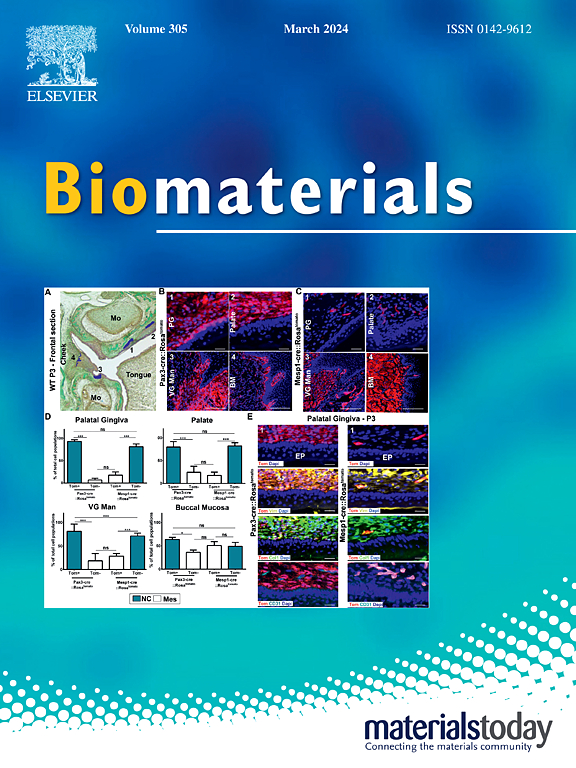激光促进过氧化物酶样水凝胶,同时监测和消除伤口感染
IF 12.8
1区 医学
Q1 ENGINEERING, BIOMEDICAL
引用次数: 0
摘要
临床上,尽管在防治急慢性伤口的侵袭性细菌感染方面已经做出了巨大的努力,但抗菌药物的滥用或过度使用仍然给伤口管理带来了很大的障碍,这大大增加了伤口消毒中有害副作用和并发症的风险。在此,我们开发了一种MPAH水凝胶敷料,以实现实时感染监测和按需抗菌治疗。在这种情况下,我们提出了一种创造性的策略,即应用激光促进的MPAH光分解H2O2来触发活性氧(ROS)的爆发释放,从而消除细菌。利用pH变异性和激光介导的ROS爆发释放的可见指示,MPAH可以实时监测伤口感染状态,同时在低H2O2剂量下赋予其优越的按需抗菌活性。除此之外,MPAH还提供了良好的愈合环境,协同促进伤口愈合和再上皮化。有了这些优点,MPAH在伤口消毒方面具有巨大的潜力,同时解决了常规使用的医用H2O2 (3%, V/V)的组织毒性问题。因此,我们的研究不仅开创了一种有前景的替代抗菌策略的探索,更令人兴奋的是,也为激光促进H2O2光分解的潜在生物医学应用开辟了广阔的前景。本文章由计算机程序翻译,如有差异,请以英文原文为准。

Laser-facilitated peroxidase-like hydrogel with simultaneous wound infection monitoring and eliminating
Clinically, despite tremendous efforts having been devoted to preventing the invasive bacterial infection in acute and chronic wounds, the abuse or excessive use of antibacterial agents still poses great hurdles for wound management, which significantly raises the risk of detrimental side-effects and complications in the wound disinfection. Herein, we develop a hydrogel dressing of MPAH to attain real-time infection monitoring and on-demand antibacterial therapy. In this scenario, we propose a creative strategy of applying laser-facilitated MPAH photodecomposition of H2O2 to trigger the burst release of reactive oxygen species (ROS) and thus eliminate bacteria. Taking advantage of the visible indication of pH variability and laser-mediated ROS burst release, MPAH permits real-time monitoring of wound infection status and simultaneously endows it with superior on-demand antibacterial activity at a low H2O2 dosage. Beyond that, MPAH also provides a favorable healing environment synergistically promotes wound closure and re-epithelialization. With these merits, MPAH presents a vast potential for wound disinfection and simultaneously addresses the histotoxicity issues of routinely used medical H2O2 (3 %, V/V). Therefore, our study not only pioneers the exploration of a promising alternative antibacterial strategy, but more excitingly, also opens a profound vista for potential biomedical applications of laser-facilitated H2O2 photodecomposition.
求助全文
通过发布文献求助,成功后即可免费获取论文全文。
去求助
来源期刊

Biomaterials
工程技术-材料科学:生物材料
CiteScore
26.00
自引率
2.90%
发文量
565
审稿时长
46 days
期刊介绍:
Biomaterials is an international journal covering the science and clinical application of biomaterials. A biomaterial is now defined as a substance that has been engineered to take a form which, alone or as part of a complex system, is used to direct, by control of interactions with components of living systems, the course of any therapeutic or diagnostic procedure. It is the aim of the journal to provide a peer-reviewed forum for the publication of original papers and authoritative review and opinion papers dealing with the most important issues facing the use of biomaterials in clinical practice. The scope of the journal covers the wide range of physical, biological and chemical sciences that underpin the design of biomaterials and the clinical disciplines in which they are used. These sciences include polymer synthesis and characterization, drug and gene vector design, the biology of the host response, immunology and toxicology and self assembly at the nanoscale. Clinical applications include the therapies of medical technology and regenerative medicine in all clinical disciplines, and diagnostic systems that reply on innovative contrast and sensing agents. The journal is relevant to areas such as cancer diagnosis and therapy, implantable devices, drug delivery systems, gene vectors, bionanotechnology and tissue engineering.
 求助内容:
求助内容: 应助结果提醒方式:
应助结果提醒方式:


